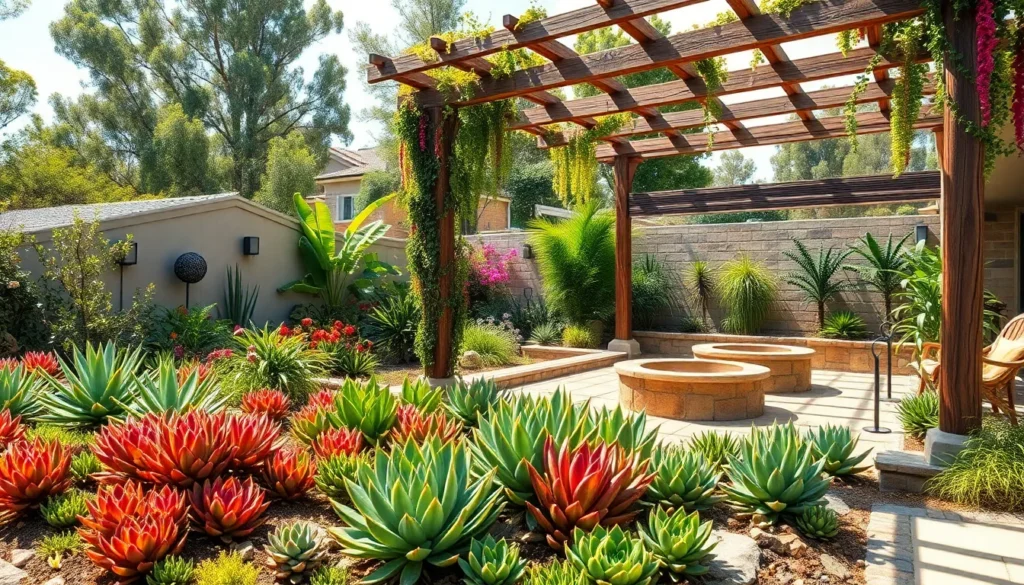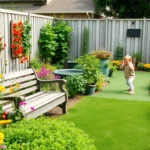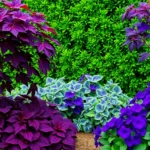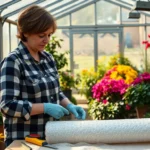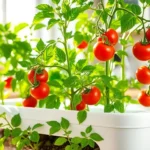Australia’s diverse landscapes and unique climate present incredible opportunities for creating stunning outdoor spaces that thrive year-round. We’ve discovered that Australian gardens can showcase native beauty while offering practical answers for water conservation and low-maintenance living.
From drought-tolerant succulents to vibrant native flowering plants Australian garden design embraces both sustainability and style. We’ll explore how incorporating indigenous species like kangaroo paw banksia and eucalyptus creates gardens that naturally adapt to local conditions while supporting native wildlife.
Whether you’re working with coastal sandy soils inland clay or temperate mountain regions we’ve gathered inspiring Australian garden ideas that’ll transform your outdoor space. These designs celebrate the continent’s natural heritage while creating functional beautiful areas perfect for entertaining relaxing and connecting with nature.
Create a Native Plant Paradise With Indigenous Australian Flora
Australia’s indigenous flora offers unmatched beauty and resilience for creating stunning gardens that thrive naturally in our diverse climate. We’ll explore how native plants can transform your outdoor space into a sustainable paradise.
Choose Drought-Tolerant Eucalyptus Trees
Eucalyptus trees provide exceptional structure and year-round interest while requiring minimal water once established. We recommend selecting varieties like Eucalyptus caesia (Silver Princess) for smaller gardens or Eucalyptus leucoxylon (South Australian Blue Gum) for larger spaces.
Red flowering gum (Eucalyptus ficifolia) creates spectacular seasonal displays with vibrant blooms ranging from deep crimson to bright orange. These hardy trees adapt to poor soils and extreme weather conditions that would challenge exotic species.
Consider spacing requirements when planting eucalyptus trees, as mature specimens can reach 15-30 meters depending on the variety. Position them strategically to provide natural windbreaks and create dappled shade for understory plantings.
Incorporate Colorful Banksia Shrubs
Banksia shrubs deliver bold architectural forms and stunning flower spikes that attract native birds throughout the year. We suggest planting Banksia spinulosa (Hairpin Banksia) for golden cylindrical flowers or Banksia ericifolia (Heath Banksia) for distinctive orange bottlebrush blooms.
Coastal banksia (Banksia integrifolia) thrives in sandy soils and salt-laden environments, making it perfect for seaside gardens. This versatile shrub produces pale yellow flower spikes from autumn through winter when most other plants remain dormant.
Group banksia varieties in odd numbers to create natural clusters that mimic their wild growing patterns. Allow adequate spacing between plants to showcase their unique sculptural qualities and prevent overcrowding as they mature.
Add Texture With Native Grasses
Native grasses introduce movement and softness to balance the rigid forms of trees and shrubs in your indigenous garden. We recommend Lomandra longifolia (Spiny-headed Mat-rush) for its strappy foliage and cream flower clusters that persist through multiple seasons.
Kangaroo grass (Themeda triandra) provides golden autumn colors and delicate seed heads that dance in gentle breezes. This drought-resistant species forms attractive tussocks that require minimal maintenance once established.
Incorporate grasses along pathways and garden borders to create natural transitions between different planting zones. Mix fine-textured varieties like Poa labillardieri (Common Tussock Grass) with broader-leaved species to achieve visual contrast and seasonal interest.
Design a Water-Wise Garden Using Xerophytic Plants
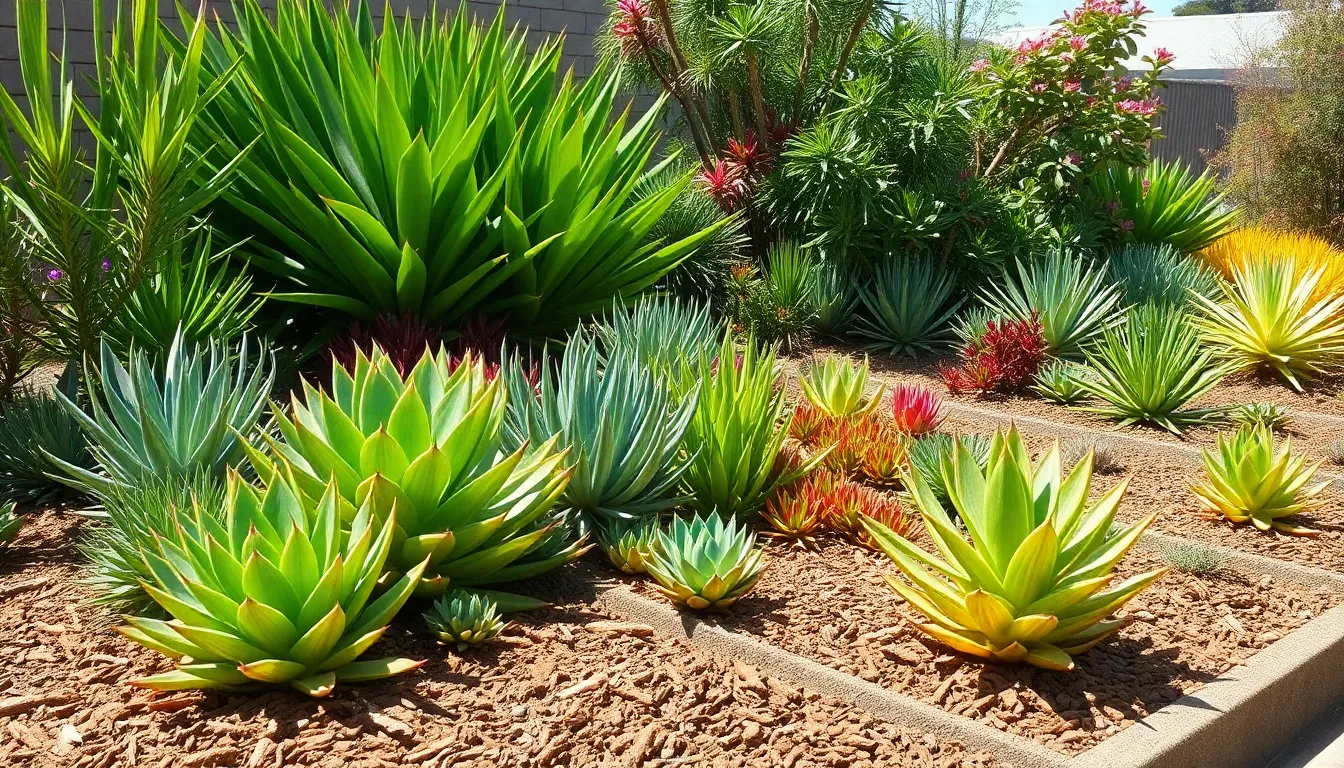
Xerophytic plants naturally thrive in arid conditions and make perfect additions to water-wise Australian gardens. These specialized plants store water efficiently and require minimal irrigation, making them ideal for regions with limited rainfall like Perth.
Install Succulent Garden Beds
Succulent garden beds create stunning focal points while dramatically reducing water consumption. These remarkable plants store water in their leaves, stems, or roots, allowing them to survive extended dry periods without supplemental watering. Popular varieties like jade plants, aloe vera, and echeveria add vibrant colors and interesting textures to garden spaces.
Design raised beds or container arrangements to showcase different succulent varieties together. Group plants with similar growing requirements to optimize their performance and create visually appealing displays. Position these beds in sunny locations where they’ll receive morning light but afternoon protection in extremely hot climates.
Use Mulch to Retain Soil Moisture
Mulching provides essential moisture retention while suppressing weeds that compete for precious water resources. Organic mulch materials like wood chips or bark create insulating layers that keep soil temperatures cool and reduce evaporation rates significantly. Apply mulch around xerophytic plants to maintain consistent soil moisture levels.
Choose appropriate mulch depth based on plant requirements, typically 2-4 inches for most garden areas. Keep mulch several inches away from plant stems to prevent moisture related problems and pest issues. Replace organic mulch annually as it decomposes and enriches the soil naturally.
Carry out Drip Irrigation Systems
Drip irrigation systems deliver precise water amounts directly to plant root zones, minimizing waste and maximizing efficiency. These targeted watering methods reduce runoff and evaporation by up to 50% compared to traditional sprinkler systems. Install drip lines or emitters near individual plants to ensure consistent moisture delivery.
Configure irrigation zones based on plant water requirements through hydrozoning techniques. Program timers to water during early morning hours when evaporation rates are lowest. Monitor soil moisture levels regularly to adjust watering schedules and prevent overwatering that can damage drought adapted plants.
Build Outdoor Living Spaces Perfect for the Australian Climate
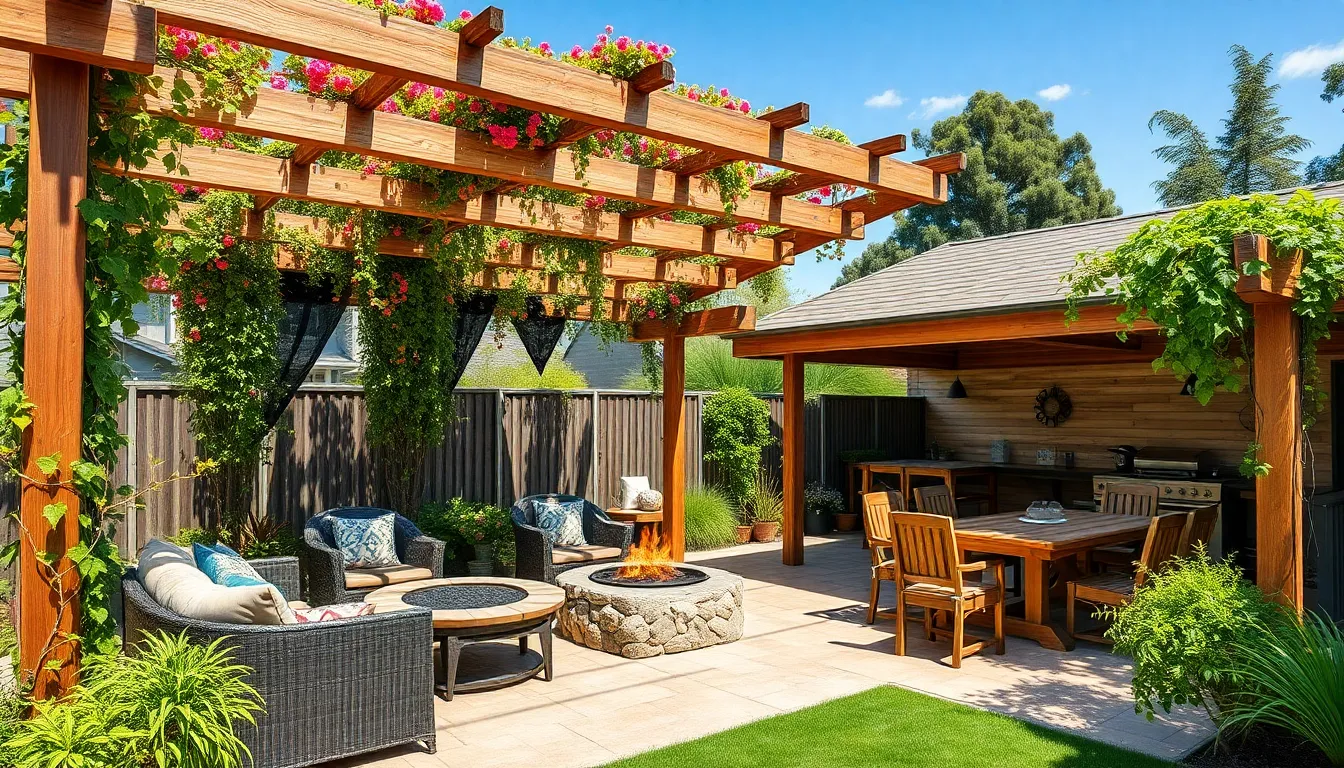
Building outdoor living spaces allows us to embrace Australia’s warm climate and create seamless transitions between indoor and outdoor areas. These functional spaces maximize our enjoyment of natural light and ventilation while providing comfortable areas for year-round entertainment and relaxation.
Construct Pergolas With Climbing Vines
Pergolas provide essential shade and architectural interest to Australian gardens, making them one of the most popular structural elements we can incorporate. Installing these overhead structures creates defined outdoor rooms while offering protection from intense sun exposure during hot summer months.
Climbing vines transform basic pergola frames into living, breathing canopies that enhance both beauty and functionality. Native banksia species create stunning displays with their distinctive cylindrical flowers, attracting native birds and adding vibrant color throughout the growing season. Native clematis offers delicate, star-shaped blooms that cascade gracefully over pergola beams, providing filtered shade while maintaining airflow underneath.
Choosing the right vine ensures long-term success and minimal maintenance requirements. Fast-growing varieties like bower vine establish quickly, creating shade within the first growing season. Slow-growing options such as native jasmine offer more controlled coverage with intensely fragrant flowers that bloom during cooler months.
Design Fire Pit Areas for Year-Round Use
Fire pit areas extend our outdoor living season by providing warmth during cooler months and creating cozy gathering spaces for social entertainment. Integrating these features into existing seating arrangements transforms ordinary patios into inviting focal points that draw family and friends together.
Planning fire pit placement requires careful consideration of wind patterns, safety clearances, and proximity to seating areas. Position fire pits at least 10 feet away from structures and overhanging branches to ensure safe operation. Installing windbreaks using natural stone walls or planted screens helps control smoke direction while adding visual interest to the design.
Selecting appropriate fire pit styles depends on our available space and intended use patterns. Built-in stone fire pits create permanent focal points that complement hardscape materials used throughout the garden. Portable options offer flexibility for smaller spaces or seasonal arrangements, allowing us to reconfigure outdoor areas as needed.
Create Covered Dining Spaces
Covered dining spaces protect us from Australia’s intense sun and unpredictable weather while maintaining our connection to the outdoor environment. These sheltered areas allow for comfortable dining experiences regardless of seasonal conditions or time of day.
Material selection impacts both durability and aesthetic appeal of covered dining structures. Wood pergolas with corrugated metal roofing provide rustic charm while offering complete weather protection. Canvas shade sails create modern, flexible coverage that can be adjusted or removed based on seasonal requirements.
Designing proper ventilation prevents covered spaces from becoming uncomfortably hot during summer months. Installing ceiling fans or creating cross-ventilation through strategic openings maintains comfortable temperatures while reducing reliance on artificial cooling systems. Incorporating retractable panels allows us to customize the level of enclosure based on weather conditions and desired atmosphere.
Incorporate Coastal Garden Elements for Seaside Appeal
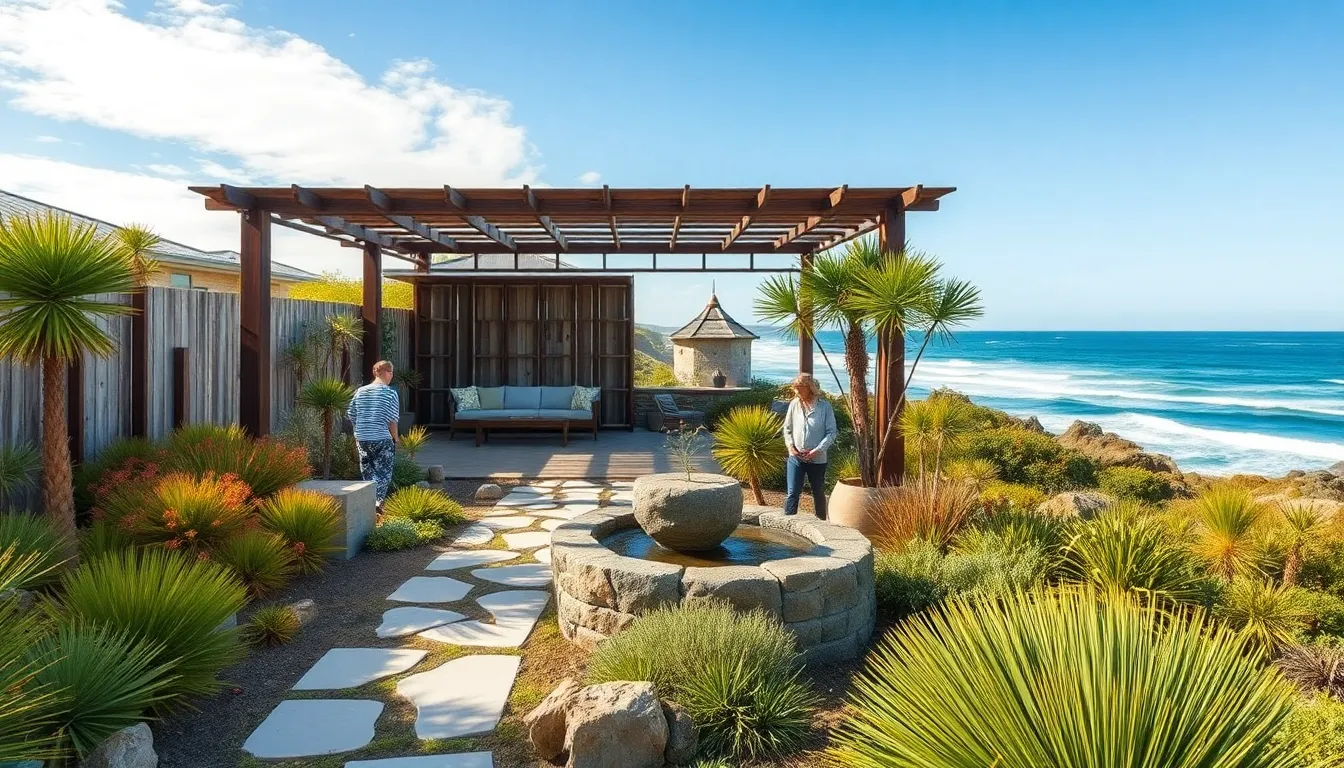
Australia’s coastal regions offer unique opportunities to create gardens that capture the raw beauty and resilience of seaside environments. We can transform our outdoor spaces by embracing elements that thrive in salt air and windy conditions.
Plant Salt-Tolerant Vegetation
Salt tolerant plants form the backbone of successful coastal gardens, withstanding harsh marine environments while maintaining their natural beauty. Casuarinas and Correa lead our plant selection for their exceptional ability to handle salt exposure and coastal winds. These hardy natives require minimal maintenance once established, making them perfect for busy homeowners seeking low maintenance answers.
Banksia varieties excel in coastal conditions, offering striking flower displays that attract native birds throughout the year. Grevillea species provide year round color and texture while supporting local wildlife populations. Kangaroo paw adds distinctive Australian character with its unique sculptural blooms that thrive in sandy coastal soils.
Local species adapted to coastal conditions minimize our garden maintenance requirements while ensuring long term plant survival. Native plants naturally resist salt spray damage and establish deeper root systems to anchor against strong winds. Choosing indigenous varieties creates authentic Australian garden character while supporting regional ecosystems.
Use Weathered Wood and Natural Stone
Weathered wood elements instantly create that coveted rustic coastal atmosphere we’re seeking in our garden designs. Eucalyptus timber fencing provides natural weather resistance while developing beautiful silver gray patinas over time. These organic materials blend seamlessly with coastal landscapes, creating visual harmony between built structures and natural surroundings.
Natural stone pathways guide visitors through our coastal gardens while withstanding salt air and weather extremes. Stone features enhance the garden’s natural beauty by echoing the rugged textures found along Australia’s coastline. Stepping stones create organic movement patterns that feel authentically coastal while providing practical navigation through planted areas.
Combining weathered timber with natural stone creates layered textures that mirror the complexity of coastal environments. These materials age gracefully, developing character that actually improves with time and weather exposure. The contrast between smooth stones and rough timber adds visual interest while maintaining the cohesive coastal aesthetic we desire.
Install Wind Resistant Garden Features
Wind resistant features ensure our coastal gardens remain beautiful and functional even though challenging weather conditions. Deep planting techniques and proper anchoring methods secure plants against strong coastal winds that can damage shallow rooted specimens. Strategic placement of larger plants creates natural windbreaks that protect more delicate species in sheltered microclimates.
Sturdy garden structures like pizza ovens and ponds withstand coastal wind conditions when properly constructed with appropriate materials and foundations. These features become focal points that enhance outdoor living while resisting the environmental challenges unique to seaside locations. Robust construction methods ensure longevity even though exposure to salt air and weather extremes.
Outdoor showers surrounded by tropical plantings create resort style experiences while utilizing wind resistant design principles. Proper drainage and material selection prevent salt buildup and wind damage to shower fixtures and surrounding plants. These installations combine functionality with coastal aesthetics, transforming necessary features into garden highlights that celebrate our seaside location.
Establish Edible Gardens Suited to Australian Growing Conditions
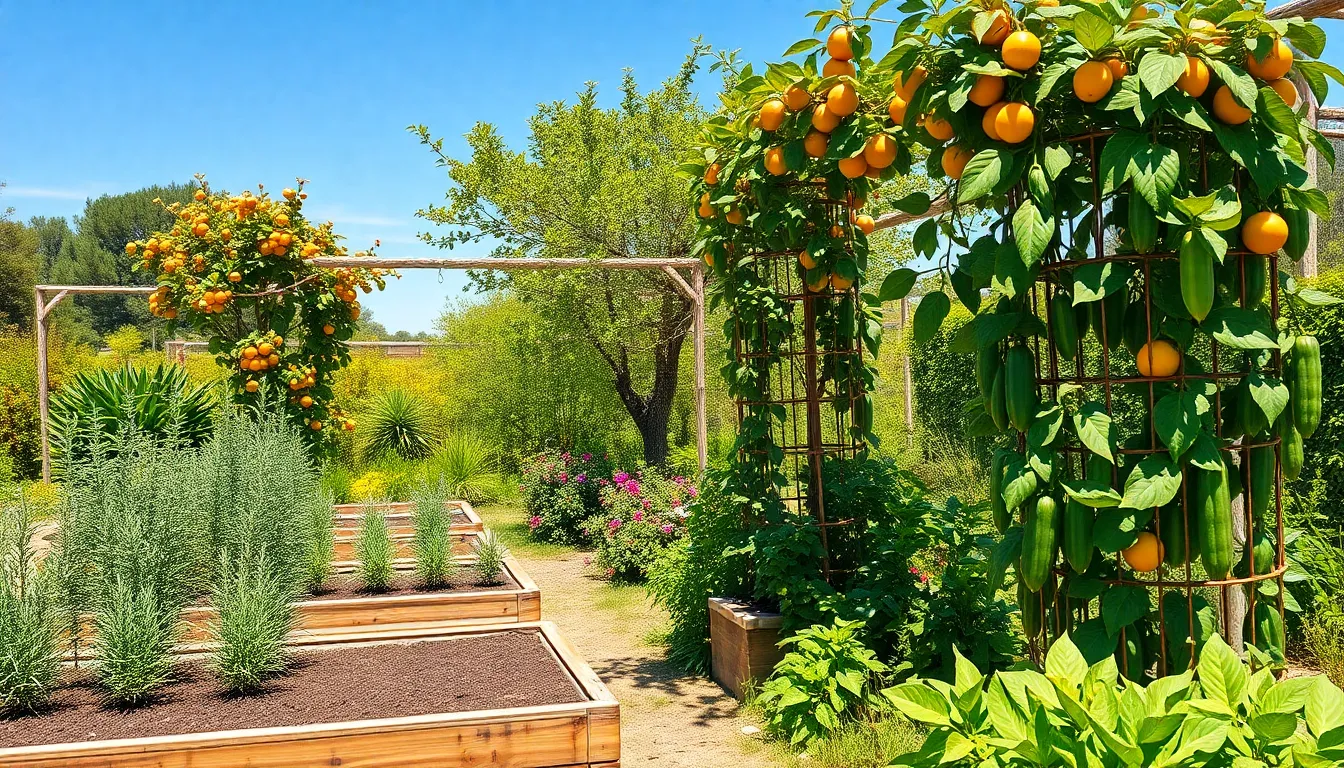
Building on our water-wise landscaping foundation, we can transform our outdoor spaces into productive edible gardens that thrive in Australia’s diverse climate zones. Smart plant selection and strategic placement maximize yields while minimizing maintenance across our continent’s six distinct growing regions.
Grow Mediterranean Herbs in Raised Beds
Mediterranean herbs flourish in Australia’s climate conditions, offering us aromatic additions that require minimal water once established. Rosemary, thyme, and oregano adapt beautifully to our sandy coastal soils and arid inland regions, providing fresh flavors year-round.
Raised beds deliver improved drainage that prevents root rot in heavy clay soils common across many Australian regions. We position these elevated growing spaces in areas receiving 6-8 hours of daily sunlight for optimal herb development. Filling raised beds with well-draining potting mix specifically designed for Mediterranean plants ensures proper soil conditions.
Benefits extend beyond better drainage to include superior pest control and easier harvesting access. We construct beds 60-80cm high to reduce bending while maintaining crops, making garden maintenance more comfortable for extended growing seasons.
Plant Citrus Trees in Sunny Locations
Citrus trees transform sunny garden corners into productive focal points that deliver fresh fruit throughout Australia’s growing seasons. We select varieties like Meyer lemons, Washington navels, and Ruby Red grapefruits that perform exceptionally in our full-sun locations receiving 8+ hours of direct sunlight daily.
Layered planting techniques create visually appealing gardens by combining citrus trees with mid-level shrubs and ground covers beneath their canopies. We plant lavender, native violets, or low-growing herbs around tree bases to maximize space utilization while creating stunning seasonal displays.
Positioning citrus trees near outdoor living areas provides convenient access to fresh fruit while their fragrant blossoms enhance our entertainment spaces. We ensure adequate spacing between trees to allow air circulation and prevent fungal diseases common in humid coastal regions.
Create Vertical Vegetable Gardens
Vertical gardens maximize growing space by utilizing walls, fences, and trellises to support climbing vegetables like beans, cucumbers, and cherry tomatoes. We install sturdy support structures capable of handling mature plant weight plus fruit loads during peak harvest periods.
Urban gardening benefits significantly from vertical growing systems that transform small courtyards into productive food sources. We select compact vegetable varieties specifically bred for container and vertical growing, ensuring optimal yields in limited spaces.
Positioning vertical gardens on north-facing walls captures maximum sunlight exposure while protecting plants from harsh afternoon heat in warmer Australian regions. We integrate drip irrigation systems into vertical setups to deliver consistent moisture directly to plant root zones without water waste.
Design Rock Gardens That Thrive in Hot, Dry Conditions
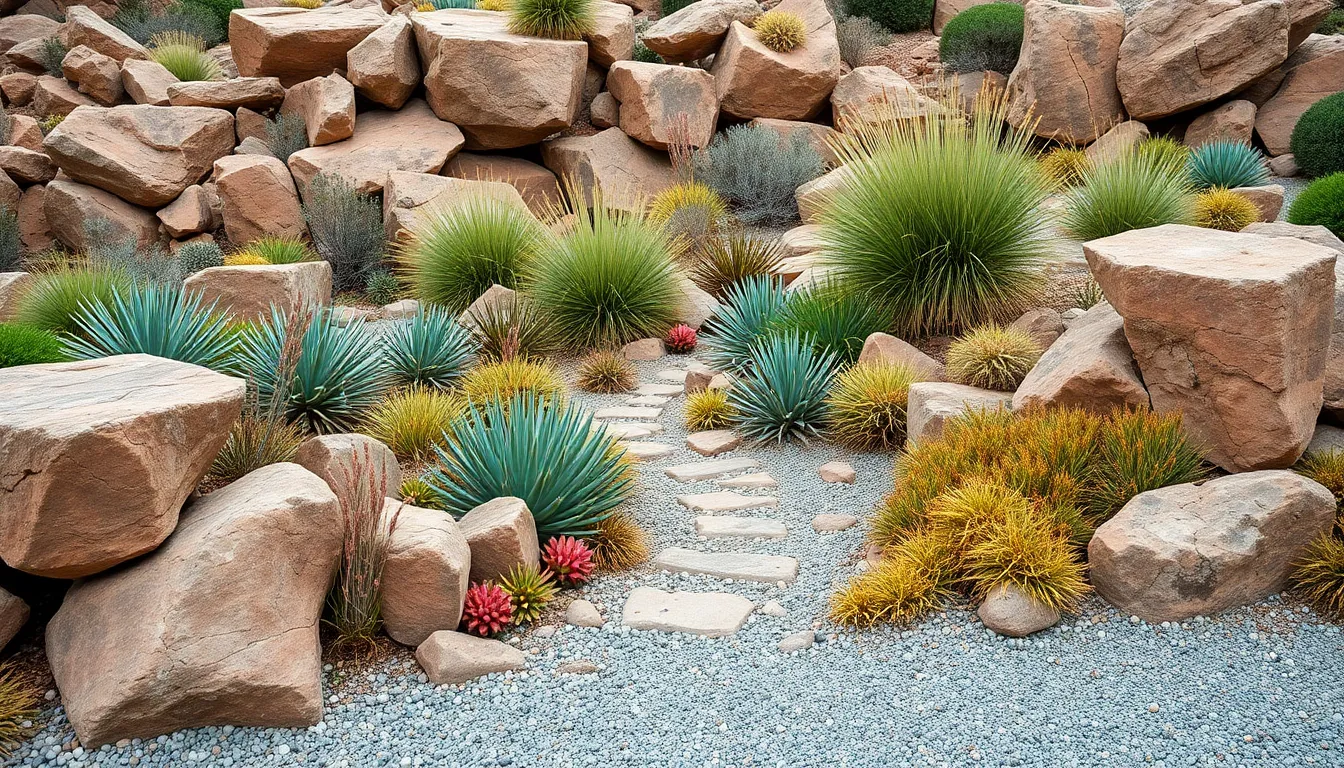
Rock gardens offer an elegant solution for transforming challenging areas into stunning landscapes that celebrate Australia’s natural resilience. We’ll explore how to create these drought tolerant displays that reduce maintenance while maximizing visual impact.
Select Heat-Resistant Alpine Plants
Choosing drought adapted species forms the foundation of successful rock garden design in Australia’s harsh climate. Succulents provide exceptional heat tolerance while offering diverse textures and colors that create year round interest. Kangaroo Paw delivers vibrant red and yellow blooms that attract native birds while requiring minimal water once established.
Alpine plants naturally thrive in rocky terrain with excellent drainage and intense sun exposure. Cushion Bush creates dense, silvery mounds that contrast beautifully with colorful flowering plants. These native species evolved to withstand Australia’s extreme temperatures and extended dry periods.
Combining different plant heights creates visual depth within rock garden compositions. Taller succulents like aloe varieties serve as focal points while ground covering alpines fill spaces between rocks. We recommend grouping plants with similar water requirements to simplify irrigation scheduling and prevent overwatering sensitive species.
Arrange Natural Stone Features
Incorporating boulders and decorative rocks creates the structural backbone of heat resistant garden designs. Natural stone features retain soil moisture during hot days while providing thermal mass that moderates temperature fluctuations around plant roots. Gravel pathways connect different garden areas while reducing lawn maintenance requirements significantly.
Strategic boulder placement establishes focal points that anchor the overall design composition. Varying stone sizes from large statement rocks to smaller accent pieces creates natural looking arrangements that mimic Australia’s rugged landscapes. These elements provide windbreaks for delicate plants while creating microclimates with improved growing conditions.
Stone selection should complement your home’s exterior materials and regional geology for authentic appeal. Sandstone weathers beautifully in coastal areas while granite performs exceptionally in inland regions with extreme temperature variations. We suggest sourcing local stone varieties to reduce transportation costs and ensure climate compatibility.
Create Drainage Answers for Sloped Areas
Sloped terrain presents unique opportunities for innovative rock garden drainage systems that prevent erosion while showcasing plants effectively. Dry stream beds with small recycling ponds manage water runoff naturally during heavy rainfall periods. These features add movement and sound to garden spaces while supporting beneficial wildlife habitat.
Terracing steep slopes with retaining walls creates level planting areas that prevent soil loss and improve water infiltration. Natural stone walls blend seamlessly with rock garden aesthetics while providing structural support for challenging terrain. Each terrace level accommodates different plant communities based on drainage and sun exposure requirements.
Installing French drains beneath rock features directs excess water away from plant root zones during wet seasons. Proper drainage prevents root rot in drought adapted species that struggle with waterlogged soil conditions. We recommend incorporating permeable materials like crushed granite between stone layers to enhance water movement and soil aeration.
Add Water Features That Complement the Australian Landscape
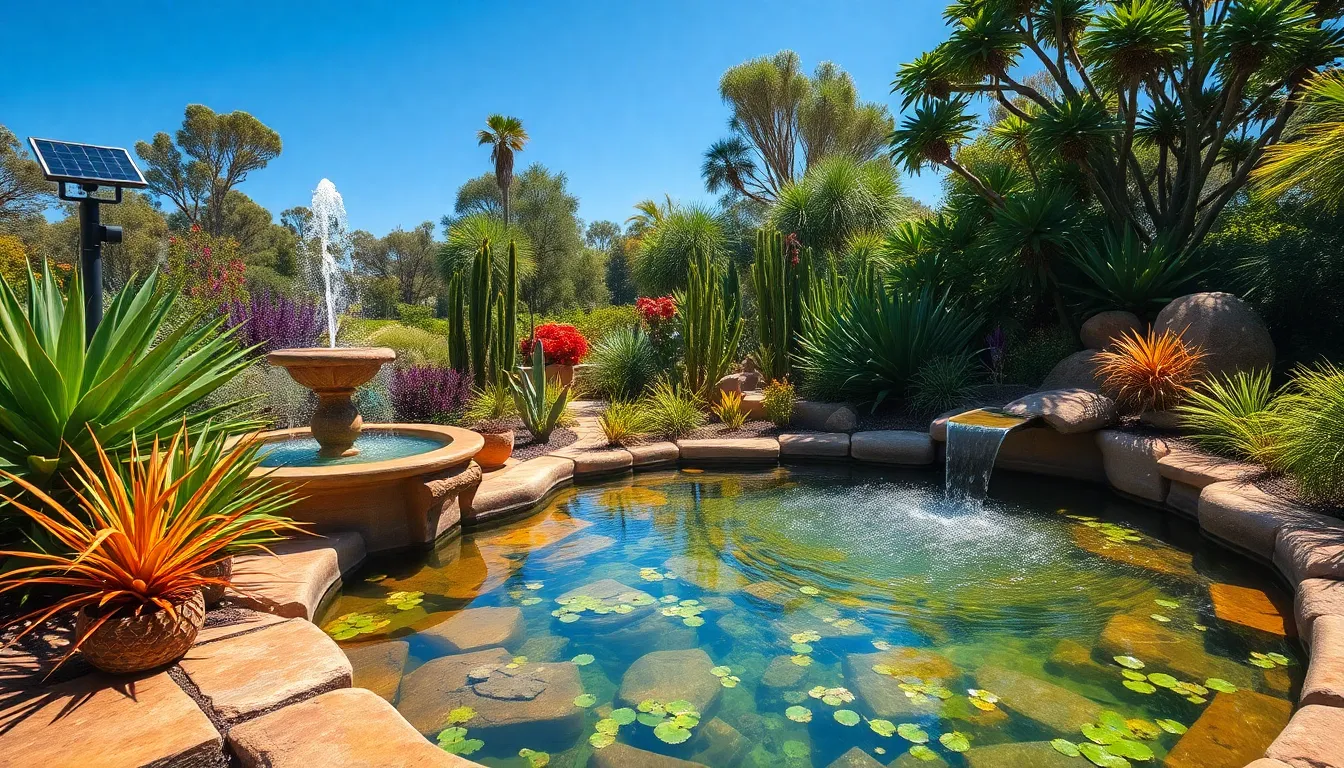
Water features transform Australian gardens into sustainable oases that work harmoniously with our continent’s unique climate patterns. These eco-friendly additions not only enhance the visual appeal of outdoor spaces but also provide practical answers for water conservation and wildlife habitat creation.
Install Solar-Powered Water Fountains
Solar-powered water fountains offer an eco-friendly solution that harnesses Australia’s abundant sunshine while adding soothing sounds to your garden space. These fountains operate independently from electrical grids, making them perfect for remote garden areas or locations where traditional power connections aren’t feasible. We recommend positioning solar fountains in areas that receive at least 6-8 hours of direct sunlight daily to ensure optimal performance throughout the year.
Modern solar fountain designs range from contemporary geometric styles to natural stone formations that blend seamlessly with native plantings. Battery backup systems in many models allow fountains to continue operating during cloudy periods or evening hours. Maintenance requirements remain minimal since these systems don’t require complex wiring or ongoing electricity costs, making them ideal for low-maintenance Australian gardens.
Installation typically involves simple assembly and positioning, with most units requiring only basic leveling and water filling. Choose models with adjustable flow rates to create different water effects, from gentle bubbling to more dramatic spray patterns that can help cool surrounding air during hot summer months.
Create Natural Swimming Pools
Natural swimming pools blend seamlessly into Australian landscapes while using biological filtration systems instead of harsh chemicals for water purification. These pools incorporate native aquatic plants and beneficial bacteria to maintain crystal-clear water through natural processes. We design regeneration zones alongside swimming areas, where plants like water lilies, rushes, and native sedges filter nutrients and support local wildlife.
Construction involves creating distinct zones with different depths to accommodate both swimming activities and plant growth requirements. Swimming areas typically maintain depths of 1.5-2 meters, while regeneration zones range from shallow plant beds to deeper biological filters. Natural stone coping and pebble beaches create organic transitions between pool areas and surrounding garden spaces.
Pump systems circulate water through gravel bed filters and plant zones, requiring less energy than traditional pool filtration equipment. Seasonal maintenance involves managing plant growth and removing organic debris, but chemical testing and shocking become unnecessary with properly balanced biological systems.
Design Rainwater Collection Gardens
Rainwater collection gardens capture and use Australia’s sporadic rainfall patterns while creating beautiful and sustainable industry features. These gardens incorporate swales, rain gardens, and bioretention areas that collect runoff from roofs, driveways, and other hard surfaces. We position these collection areas strategically to channel water toward drought-tolerant native plants that benefit from periodic deep watering.
Rain garden construction involves creating shallow depressions filled with permeable soil mixes and planted with moisture-loving natives like lomandra, native violets, and kangaroo grass. These plants tolerate both wet and dry conditions, thriving during rain events while surviving extended drought periods. Overflow systems direct excess water to secondary collection areas or existing drainage systems during heavy rainfall.
Decorative elements like river rocks, timber edging, and sculptural plantings transform functional water collection into attractive garden focal points. Underground storage tanks or above-ground rainwater barrels can supplement collection gardens, providing stored water for irrigation during dry spells while reducing stormwater runoff that can cause erosion problems.
Conclusion
Creating an Australian garden that’s both beautiful and sustainable doesn’t require extensive maintenance or excessive water usage. We’ve shown you how native plants like banksia and eucalyptus can form the backbone of stunning landscapes that thrive naturally in our diverse climate.
From water-wise succulent beds to productive edible gardens we can design outdoor spaces that celebrate Australia’s unique flora while meeting our practical needs. The combination of rock gardens fire pits and rainwater collection systems proves that functional design can be incredibly attractive.
Whether you’re working with a small urban balcony or expansive rural property these Australian garden ideas will help you create an outdoor haven that’s perfectly suited to our environment. Start with native plants add water-saving features and watch your garden flourish with minimal effort.
Frequently Asked Questions
What are the best native Australian plants for water-wise gardens?
Kangaroo paw, banksia, and eucalyptus are excellent choices for water-wise Australian gardens. These indigenous plants naturally thrive in diverse climates while requiring minimal irrigation. Drought-tolerant eucalyptus varieties like Eucalyptus caesia provide structural beauty, while colorful banksia shrubs attract native wildlife. Native grasses such as Lomandra longifolia add texture and movement to garden designs.
How can I create a low-maintenance succulent garden in Australia?
Design raised beds or container arrangements using drought-tolerant succulents like jade plants, aloe vera, and echeveria. These plants thrive in arid conditions and significantly reduce water consumption. Apply organic mulch such as wood chips to retain soil moisture and suppress weeds. Consider installing drip irrigation systems for precise water delivery to plant roots.
What’s the best way to build outdoor living spaces in Australia’s climate?
Create seamless indoor-outdoor transitions by constructing pergolas with climbing native vines like banksia or clematis for natural shade. Design fire pit areas for year-round gathering spaces and covered dining areas to protect from sun and weather. Focus on materials and ventilation strategies that ensure comfort in Australia’s warm climate conditions.
How do I establish an edible garden suited to Australian conditions?
Plant Mediterranean herbs like rosemary, thyme, and oregano in raised beds for improved drainage. Position citrus trees in sunny locations for fresh fruit production. Create vertical vegetable gardens using walls and trellises to maximize space in urban settings. Integrate drip irrigation systems for efficient water delivery to edible plants.
What are effective drainage solutions for Australian gardens on slopes?
Install dry stream beds and terracing with retaining walls to manage water runoff and prevent erosion. French drains protect drought-adapted plants from waterlogged conditions. Design swales and rain gardens to channel sporadic rainfall toward drought-tolerant native plants, transforming functional drainage into attractive garden focal points.
How can I incorporate water features in drought-prone Australian landscapes?
Choose solar-powered water fountains for eco-friendly, low-maintenance water features. Consider natural swimming pools that use biological filtration systems for water purification. These features enhance visual appeal while promoting water conservation and creating wildlife habitats, making them ideal for Australia’s diverse climate conditions.

